The Responses of the Ecosystems in the Tianshan North Slope under Multiple Representative Concentration Pathway Scenarios in the Middle of the 21st Century
Abstract
1. Introduction
2. Materials and Methods
2.1. Study Area
2.2. AEM Model
2.3. Model Inputs
3. Results
3.1. Future Climate Changes under Different RCP Scenarios
3.2. Temporal and Spatial Patterns of the Regional NPP and ET
3.3. Temporal Dynamics of NPP and ET for Different Vegetation Types
3.4. Temporal Dynamics of the Water Use Efficiency
4. Discussion
4.1. Comparison with Historical Climate Change Effects
4.2. Uncertainties and Future Works
5. Conclusions
Author Contributions
Funding
Acknowledgments
Conflicts of Interest
References
- Safriel, U.; Adeel, Z. Ecosystems and human well-being: current state and trends, chapter 22: dryland systems. In Ecosystems and Human Well-Being: Current State and Trends: Findings of the Condition and Trends Working Group; Island Press: Washington, DC, USA, 2005; pp. 625–662. [Google Scholar]
- Li, C.; Zhang, C.; Luo, G.; Chen, X. Modeling the carbon dynamics of the dryland ecosystems in Xinjiang, China from 1981 to 2007—The spatiotemporal patterns and climate controls. Ecol. Model. 2013, 267, 148–157. [Google Scholar] [CrossRef]
- Li, C.; Zhang, C.; Luo, G.; Chen, X.; Maisupova, B.; Abdullo A, M.; Han, Q.; Bekmamat M, D. Carbon stock and its responses to climate change in Central Asia. Glob. Chang. Biol. 2015, 21, 1951–1967. [Google Scholar] [CrossRef] [PubMed]
- Li, C.; Han, Q.; Luo, G.; Zhao, C.; Li, S.; Wang, Y.; Yu, D. Effects of Cropland Conversion and Climate Change on Agrosystem Carbon Balance of China’s Dryland: A Typical Watershed Study. Sustainability 2018, 10, 4508. [Google Scholar] [CrossRef]
- Han, Q.; Luo, G.; Li, C.; Shakir, A.; Wu, M.; Saidov, A. Simulated grazing effects on carbon emission in Central Asia. Agric. For. Meteorol. 2016, 216, 203–214. [Google Scholar] [CrossRef]
- Huang, L.; He, B.; Chen, A.; Wang, H.; Liu, J.; Lű, A.; Chen, Z. Drought dominates the interannual variability in global terrestrial net primary production by controlling semi-arid ecosystems. Sci. Rep. 2016, 6, 24639. [Google Scholar] [CrossRef]
- Hu, Z.; Zhang, C.; Hu, Q.; Tian, H. Temperature changes in Central Asia from 1979 to 2011 based on multiple datasets. J. Clim. 2014, 27, 1143–1167. [Google Scholar] [CrossRef]
- IPCC. Summary for Policymakers of the Synthesis Report of the IPCC Fourth Assessment Report; Cambridge University Press: Cambridge, UK, 2007. [Google Scholar]
- Li, Q.; Chen, Y.; Shen, Y.; Li, X.; Xu, J. Spatial and temporal trends of climate change in Xinjiang, China. J. Geogr. Sci. 2011, 21, 1007. [Google Scholar] [CrossRef]
- Hu, Z.; Zhou, Q.; Chen, X.; Qian, C.; Wang, S.; Li, J. Variations and changes of annual precipitation in Central Asia over the last century. Int. J. Climatol. 2017, 37, 157–170. [Google Scholar] [CrossRef]
- Han, Q.; Luo, G.; Li, C.; Xu, W. Modeling the grazing effect on dry grassland carbon cycling with Biome-BGC model. Ecol. Complex. 2014, 17, 149–157. [Google Scholar] [CrossRef]
- Han, Q.; Luo, G.; Li, C.; Li, S. Response of Carbon Dynamics to Climate Change Varied among Different Vegetation Types in Central Asia. Sustainability 2018, 10, 3288. [Google Scholar] [CrossRef]
- Ahlström, A.; Raupach, M.R.; Schurgers, G.; Smith, B.; Arneth, A.; Jung, M.; Reichstein, M.; Canadell, J.G.; Friedlingstein, P.; Jain, A.K. The dominant role of semi-arid ecosystems in the trend and variability of the land CO2 sink. Science 2015, 348, 895–899. [Google Scholar] [CrossRef] [PubMed]
- Fang, X.; Zhang, C.; Wang, Q.; Chen, X.; Ding, J.; Karamage, F. Isolating and quantifying the effects of climate and CO2 changes (1980–2014) on the net primary productivity in arid and semiarid China. Forests 2017, 8, 60. [Google Scholar] [CrossRef]
- Earth’s CO2 Home Page. Available online: https://www.co2.earth/ (accessed on 1 December 2019).
- Mikkelsen, T.N.; Beier, C.; Jonasson, S.; Holmstrup, M.; Schmidt, I.K.; Ambus, P.; Pilegaard, K.; Michelsen, A.; Albert, K.; Andresen, L.C. Experimental design of multifactor climate change experiments with elevated CO2, warming and drought: the CLIMAITE project. Funct. Ecol. 2008, 22, 185–195. [Google Scholar] [CrossRef]
- Zhang, C.; Ren, W. Complex climatic and CO2 controls on net primary productivity of temperate dryland ecosystems over central Asia during 1980–2014. J. Geophys. Res.-Biogeosci. 2017, 122, 2356–2374. [Google Scholar] [CrossRef]
- Zhu, S.; Li, C.; Shao, H.; Ju, W.; Lv, N. The response of carbon stocks of drylands in Central Asia to changes of CO2 and climate during past 35 years. Sci. Total Environ. 2019, 687, 330–340. [Google Scholar] [CrossRef]
- Fang, J.; Piao, S.; Tang, Z.; Peng, C.; Ji, W. Interannual variability in net primary production and precipitation. Science 2001, 293, 1723. [Google Scholar] [CrossRef]
- Mohamed, M.; Babiker, I.S.; Chen, Z.; Ikeda, K.; Ohta, K.; Kato, K. The role of climate variability in the inter-annual variation of terrestrial net primary production (NPP). Sci. Total Environ. 2004, 332, 123–137. [Google Scholar] [CrossRef]
- Zhao, M.; Running, S.W. Drought-induced reduction in global terrestrial net primary production from 2000 through 2009. Science 2010, 329, 940–943. [Google Scholar] [CrossRef]
- Zhang, Y.; Peña-Arancibia, J.L.; McVicar, T.R.; Chiew, F.H.; Vaze, J.; Liu, C.; Lu, X.; Zheng, H.; Wang, Y.; Liu, Y.Y. Multi-decadal trends in global terrestrial evapotranspiration and its components. Sci. Rep. 2016, 6, 19124. [Google Scholar] [CrossRef]
- Wei, Z.; Yoshimura, K.; Wang, L.; Miralles, D.G.; Jasechko, S.; Lee, X. Revisiting the contribution of transpiration to global terrestrial evapotranspiration. Geophys. Res. Lett. 2017, 44, 2792–2801. [Google Scholar] [CrossRef]
- Fisher, J.B.; Melton, F.; Middleton, E.; Hain, C.; Anderson, M.; Allen, R.; McCabe, M.F.; Hook, S.; Baldocchi, D.; Townsend, P.A. The future of evapotranspiration: Global requirements for ecosystem functioning, carbon and climate feedbacks, agricultural management, and water resources. Water Resour. Res. 2017, 53, 2618–2626. [Google Scholar] [CrossRef]
- Han, Q.; Li, C.; Zhao, C.; Zhang, Y.; Li, S. Grazing decreased water use efficiency in Central Asia from 1979 to 2011. Ecol. Model. 2018, 388, 72–79. [Google Scholar] [CrossRef]
- Beadle, C.; Neilson, R.; Talbot, H.; Jarvis, P. Stomatal conductance and photosynthesis in a mature Scots pine forest. I. Diurnal, seasonal and spatial variation in shoots. J. Appl. Ecol. 1985, 22, 557–571. [Google Scholar] [CrossRef]
- Gadi, V.K.; Bordoloi, S.; Garg, A.; Sahoo, L.; Berretta, C.; Sekharan, S. Effect of shoot parameters on cracking in vegetated soil. Environ. Geotech. 2017, 5, 123–130. [Google Scholar] [CrossRef]
- Gadi, V.K.; Hussain, R.; Bordoloi, S.; Hossain, S.; Singh, S.R.; Garg, A.; Sekharan, S.; Karangat, R.; Lingaraj, S. Relating stomatal conductance and surface area with evapotranspiration induced suction in a heterogeneous grass cover. J. Hydrol. 2019, 568, 867–876. [Google Scholar] [CrossRef]
- Huang, M.; Piao, S.; Zeng, Z.; Peng, S.; Ciais, P.; Cheng, L.; Mao, J.; Poulter, B.; Shi, X.; Yao, Y. Seasonal responses of terrestrial ecosystem water-use efficiency to climate change. Glob. Chang. Biol. 2016, 22, 2165–2177. [Google Scholar] [CrossRef]
- Van Der Sleen, P.; Groenendijk, P.; Vlam, M.; Anten, N.P.; Boom, A.; Bongers, F.; Pons, T.L.; Terburg, G.; Zuidema, P.A. No growth stimulation of tropical trees by 150 years of CO2 fertilization but water-use efficiency increased. Nat. Geosci. 2015, 8, 24. [Google Scholar] [CrossRef]
- Xiao, J.; Sun, G.; Chen, J.; Chen, H.; Chen, S.; Dong, G.; Gao, S.; Guo, H.; Guo, J.; Han, S. Carbon fluxes, evapotranspiration, and water use efficiency of terrestrial ecosystems in China. Agric. Meteorol. 2013, 182, 76–90. [Google Scholar] [CrossRef]
- Zhang, T.; Peng, J.; Liang, W.; Yang, Y.; Liu, Y. Spatial–temporal patterns of water use efficiency and climate controls in China’s Loess Plateau during 2000–2010. Sci. Total Environ. 2016, 565, 105–122. [Google Scholar] [CrossRef]
- Ren, W.; Tian, H.; Tao, B.; Huang, Y.; Pan, S. C hina’s crop productivity and soil carbon storage as influenced by multifactor global change. Glob. Chang. Biol. 2012, 18, 2945–2957. [Google Scholar] [CrossRef] [PubMed]
- Sitch, S.; Friedlingstein, P.; Gruber, N.; Jones, S.D.; Murray-Tortarolo, G.; Ahlström, A.; Doney, S.C.; Graven, H.; Heinze, C.; Huntingford, C. Recent trends and drivers of regional sources and sinks of carbon dioxide. Biogeosciences 2015, 12, 653–679. [Google Scholar] [CrossRef]
- Zhang, C.; Li, C.; Luo, G.; Chen, X. Modeling plant structure and its impacts on carbon and water cycles of the Central Asian arid ecosystem in the context of climate change. Ecol. Model. 2013, 267, 158–179. [Google Scholar] [CrossRef]
- Fang, X.; Chen, Z.; Guo, X.; Zhu, S.; Liu, T.; Li, C.; He, B. Impacts and uncertainties of climate/CO2 change on net primary productivity in Xinjiang, China (2000–2014): A modelling approach. Ecol. Model. 2019, 408, 108742. [Google Scholar] [CrossRef]
- Fang, X.; Guo, X.; Zhang, C.; Shao, H.; Zhu, S.; Li, Z.; Feng, X.; He, B. Contributions of climate change to the terrestrial carbon stock of the arid region of China: A multi-dataset analysis. Sci. Total Environ. 2019, 668, 631–644. [Google Scholar] [CrossRef] [PubMed]
- Luo, M.; Liu, T.; Frankl, A.; Duan, Y.; Meng, F.; Bao, A.; Kurban, A.; De Maeyer, P. Defining spatiotemporal characteristics of climate change trends from downscaled GCMs ensembles: how climate change reacts in Xinjiang, China. Int. J. Climatol. 2018, 38, 2538–2553. [Google Scholar] [CrossRef]
- Meinshausen, M.; Smith, S.J.; Calvin, K.; Daniel, J.S.; Kainuma, M.L.T.; Lamarque, J.-F.; Matsumoto, K.; Montzka, S.A.; Raper, S.C.B.; Riahi, K.; et al. The RCP greenhouse gas concentrations and their extensions from 1765 to 2300. Clim. Chang. 2011, 109, 213. [Google Scholar] [CrossRef]
- Gang, C.; Zhang, Y.; Wang, Z.; Chen, Y.; Yang, Y.; Li, J.; Cheng, J.; Qi, J.; Odeh, I. Modeling the dynamics of distribution, extent, and NPP of global terrestrial ecosystems in response to future climate change. Glob. Planet. Chang. 2017, 148, 153–165. [Google Scholar] [CrossRef]
- Yu, M.; Wang, G.; Parr, D.; Ahmed, K.F. Future changes of the terrestrial ecosystem based on a dynamic vegetation model driven with RCP8.5 climate projections from 19 GCMs. Clim. Chang. 2014, 127, 257–271. [Google Scholar] [CrossRef]
- Arora, V.K.; Boer, G.J. Terrestrial ecosystems response to future changes in climate and atmospheric CO2 concentration. Biogeosciences 2014, 11, 4157–4171. [Google Scholar] [CrossRef]
- Hu, R. Physical Geography of the Tianshan Mountains in China; China Environmental Science Press: Beijing, China, 2004. [Google Scholar]
- Chen, X.; Luo, G. Carbon Cycle in Dryland Ecosystems of Central Asia; China Environmental Press: Beijing, China, 2015. [Google Scholar]
- Farquhar, G.D.; Von Caemmerer, S.V.; Berry, J.A. A biochemical model of photosynthetic CO2 assimilation in leaves of C 3 species. Planta 1980, 149, 78–90. [Google Scholar] [CrossRef]
- Ryan, M.G. Effects of climate change on plant respiration. Ecol. Appl. 1991, 1, 157–167. [Google Scholar] [CrossRef]
- Sinclair, T.R.; Tanner, C.; Bennett, J. Water-use efficiency in crop production. Bioscience 1984, 34, 36–40. [Google Scholar] [CrossRef]
- Hao, X.; Ma, H.; Hua, D.; Qin, J.; Zhang, Y. Response of ecosystem water use efficiency to climate change in the Tianshan Mountains, Central Asia. Environ. Monit. Assess. 2019, 191, 561. [Google Scholar] [CrossRef]
- Xinjiang and Central Asia Data Center. Available online: http://midasia.geodata.cn/Portal/index.jsp (accessed on 12 June 2018).
- ASTER GDEM V.2. Available online: http://gdem.ersdac.jspacesystems.or.jp/ (accessed on 2 June 2018).
- Cold and Arid Regions Sciences Data Center at Lanzhou. Available online: http://westdc.westgis.ac.cn (accessed on 6 June 2018).
- Termonia, P.; Van Schaeybroeck, B.; De Cruz, L.; De Troch, R.; Caluwaerts, S.; Giot, O.; Hamdi, R.; Vannitsem, S.; Duchêne, F.; Willems, P.; et al. The CORDEX.be initiative as a foundation for climate services in Belgium. Clim. Serv. 2018, 11, 49–61. [Google Scholar] [CrossRef]
- Giorgi, F.; Jones, C.; Asrar, G.R. Addressing climate information needs at the regional level: the CORDEX framework. World Meteorol. Organ. (WMO) Bull. 2009, 58, 175–183. [Google Scholar]
- Hamdi, R.; Giot, O.; De Troch, R.; Deckmyn, A.; Termonia, P. Future climate of Brussels and Paris for the 2050s under the A1B scenario. Urban Clim. 2015, 12, 160–182. [Google Scholar] [CrossRef]
- Hamdi, R.; Van de Vyver, H.; De Troch, R.; Termonia, P. Assessment of three dynamical urban climate downscaling methods: Brussels’s future urban heat island under an A1B emission scenario. Int. J. Climatol. 2014, 34, 978–999. [Google Scholar] [CrossRef]
- Mårtensson, L.-M.; Carlsson, G.; Prade, T.; Kørup, K.; Lærke, P.E.; Jensen, E.S. Water use efficiency and shoot biomass production under water limitation is negatively correlated to the discrimination against 13C in the C3 grasses Dactylis glomerata, Festuca arundinacea and Phalaris arundinacea. Plant Physiol. Biochem. 2017, 113, 1–5. [Google Scholar] [CrossRef]
- Zou, J.; Ding, J.; Yang, S. Spatial and temporal variation analysis of ecosystem water use efficiency in Central Asia and Xinjiang in recent 15 years. Geogr. Res 2017, 36, 1742–1745. [Google Scholar] [CrossRef]
- Cui, J.; Bai, J.; Zheng, L.; Li, Y.; Zhao, H.; Yuan, X.; Li, L. Uncertainty of Evapotranspiration Products Based on Fusion of Multi-source Remote Sensing Data and Land Surface Modes in Xinjiang. Arid Zone Res. 2018, 35, 597–605. [Google Scholar] [CrossRef]
- Wang, B.; Li Liu, D.; Asseng, S.; Macadam, I.; Yang, X.; Yu, Q. Spatiotemporal changes in wheat phenology, yield and water use efficiency under the CMIP5 multimodel ensemble projections in eastern Australia. Clim. Res. 2017, 72, 83–99. [Google Scholar] [CrossRef]
- Zhang, X.; Moran, M.S.; Zhao, X.; Liu, S.; Zhou, T.; Ponce-Campos, G.E.; Liu, F. Impact of prolonged drought on rainfall use efficiency using MODIS data across China in the early 21st century. Remote Sens. Environ. 2014, 150, 188–197. [Google Scholar] [CrossRef]
- Liu, C.; He, N.; Zhang, J.; Li, Y.; Wang, Q.; Sack, L.; Yu, G. Variation of stomatal traits from cold temperate to tropical forests and association with water use efficiency. Funct. Ecol. 2018, 32, 20–28. [Google Scholar] [CrossRef]
- Luo, G.; Han, Q.; Zhou, D.; Li, L.; Chen, X.; Li, Y.; Hu, Y.; Li, B.L. Moderate grazing can promote aboveground primary production of grassland under water stress. Ecol. Complex. 2012, 11, 126–136. [Google Scholar] [CrossRef]
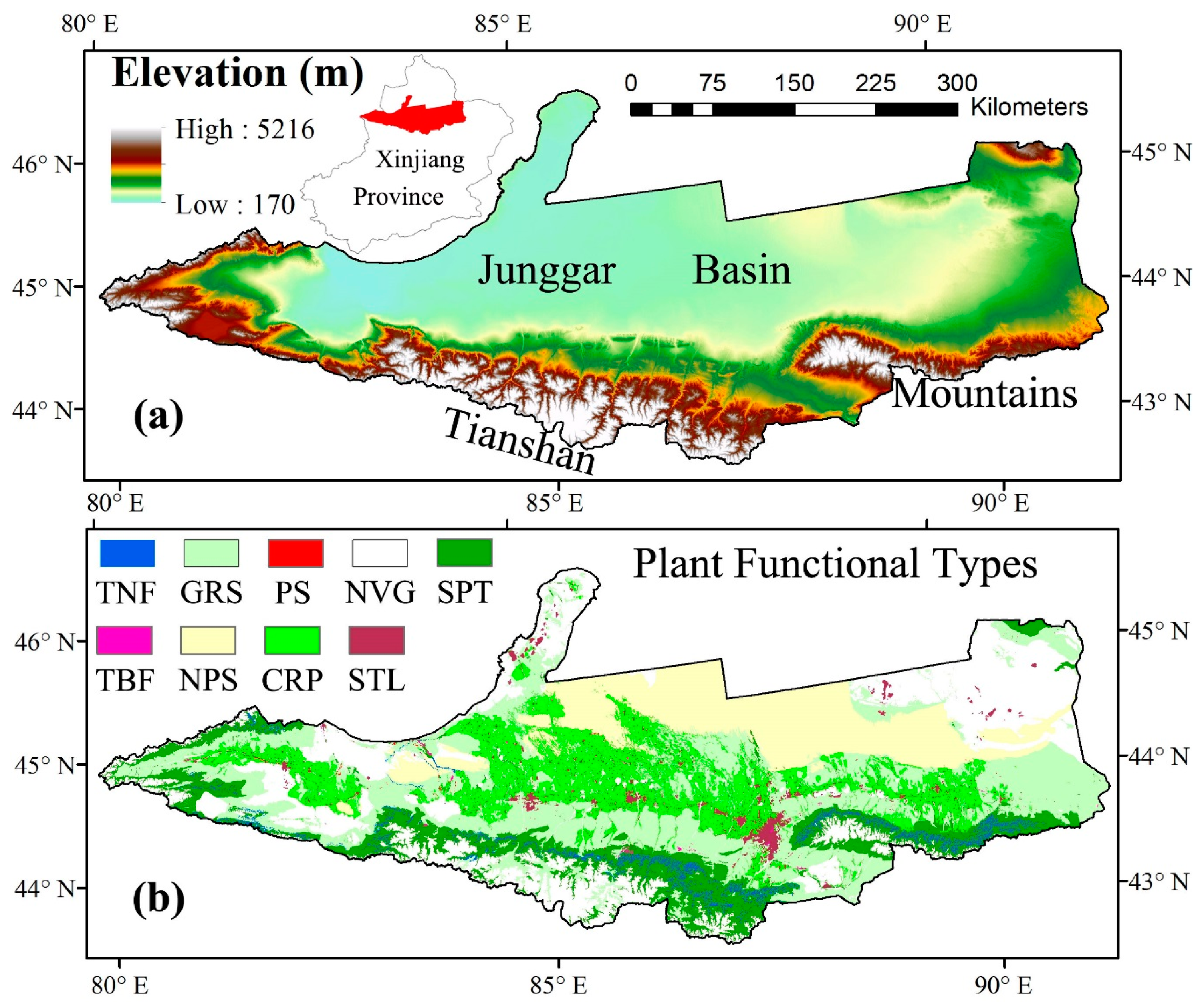
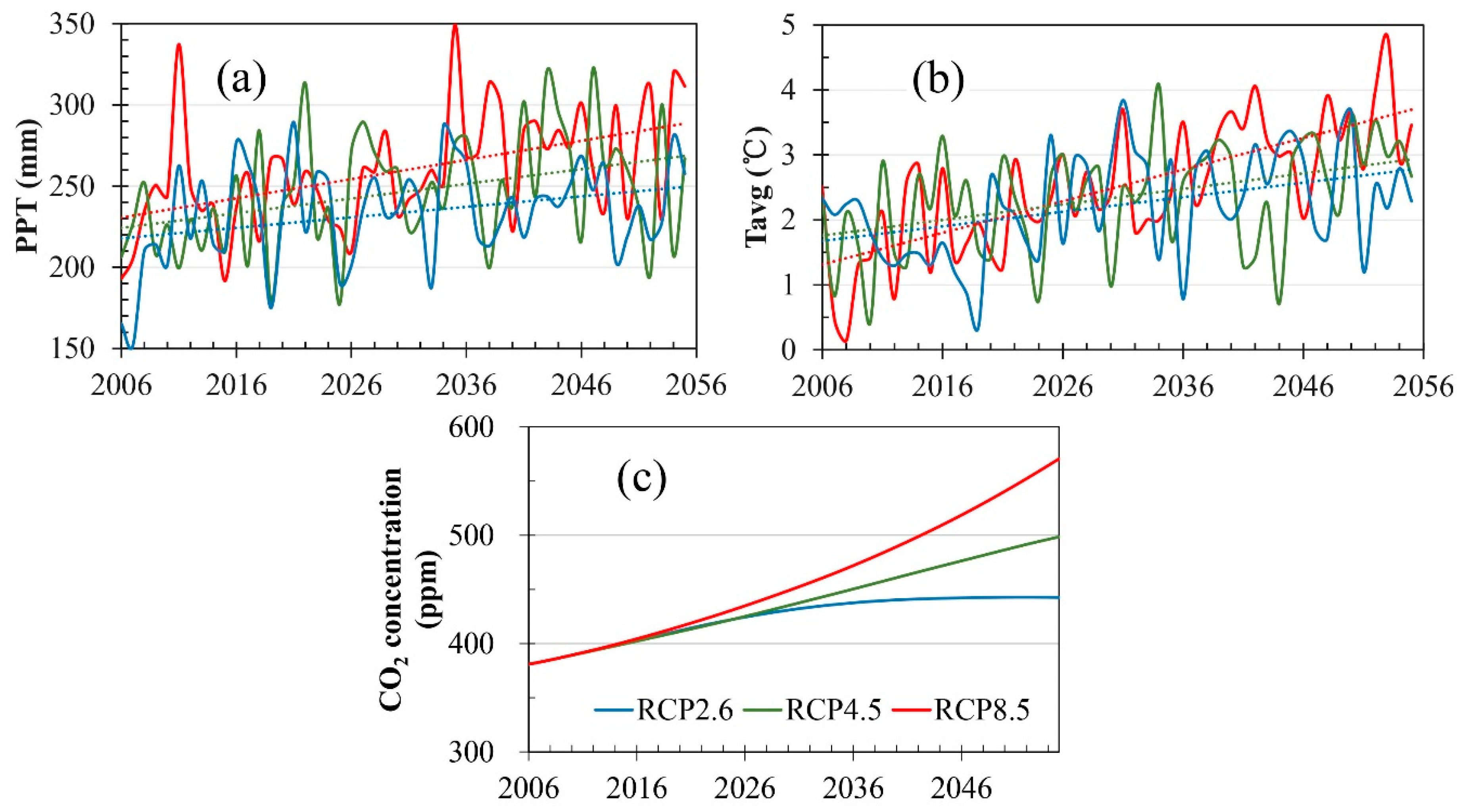
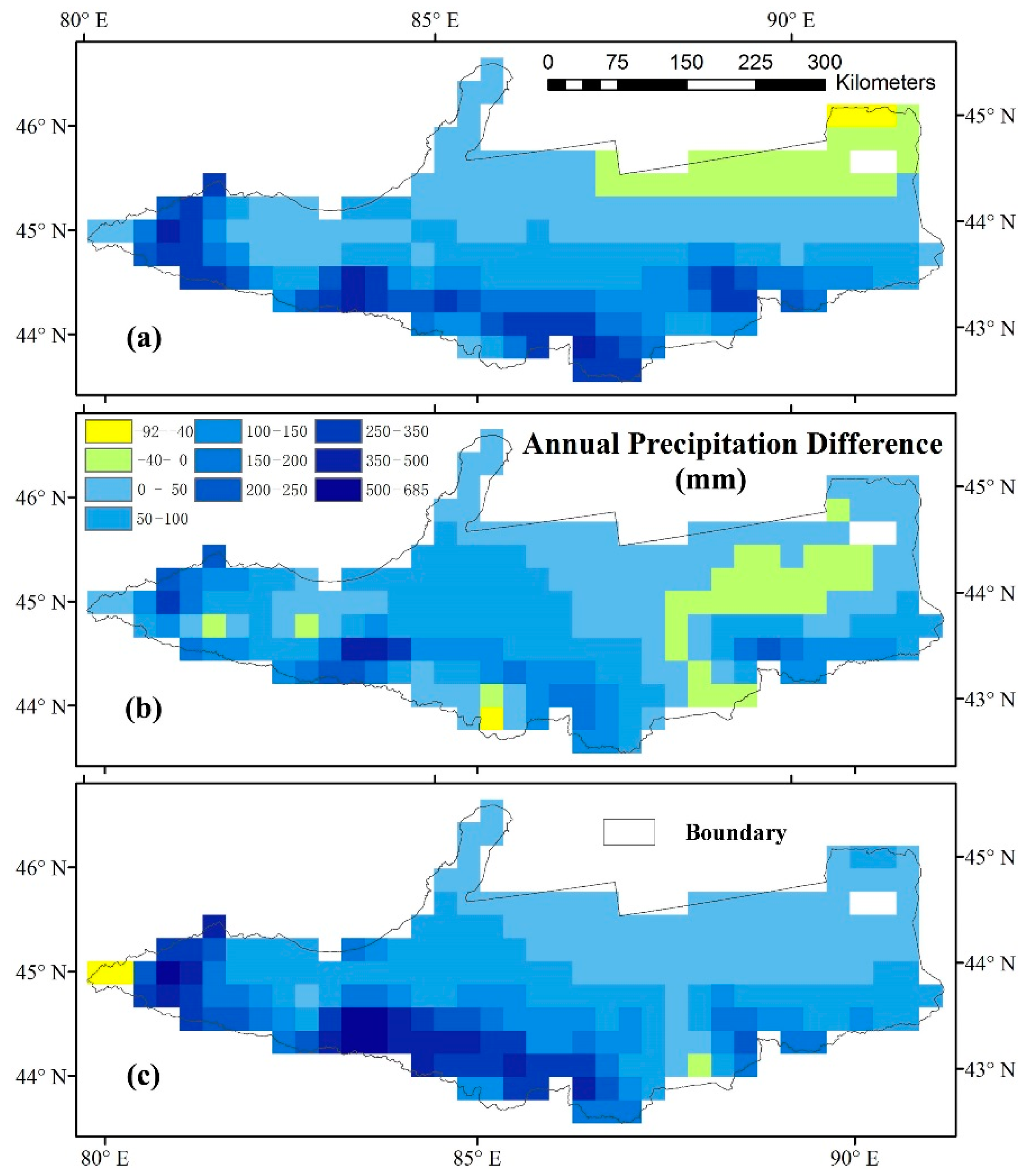
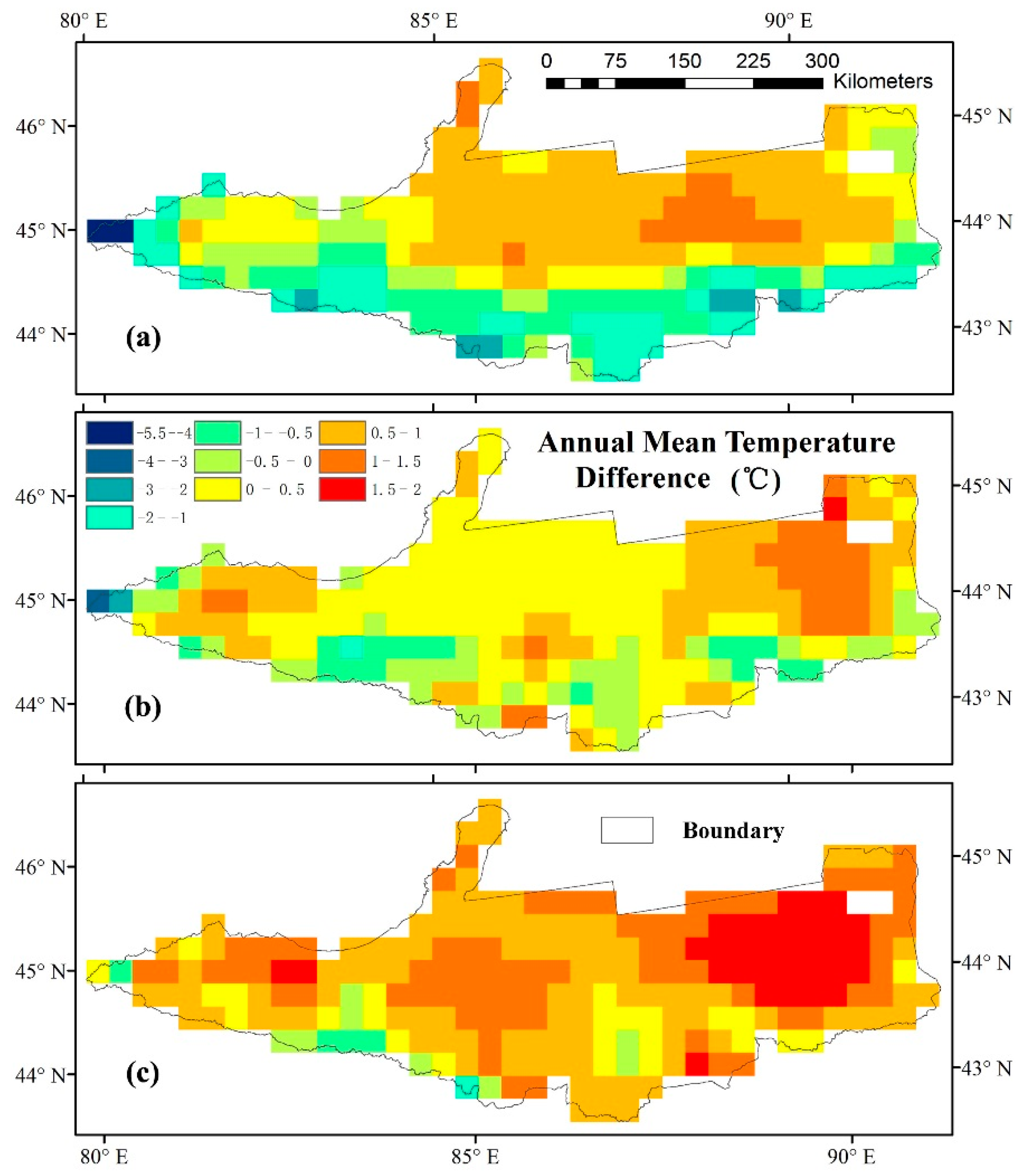

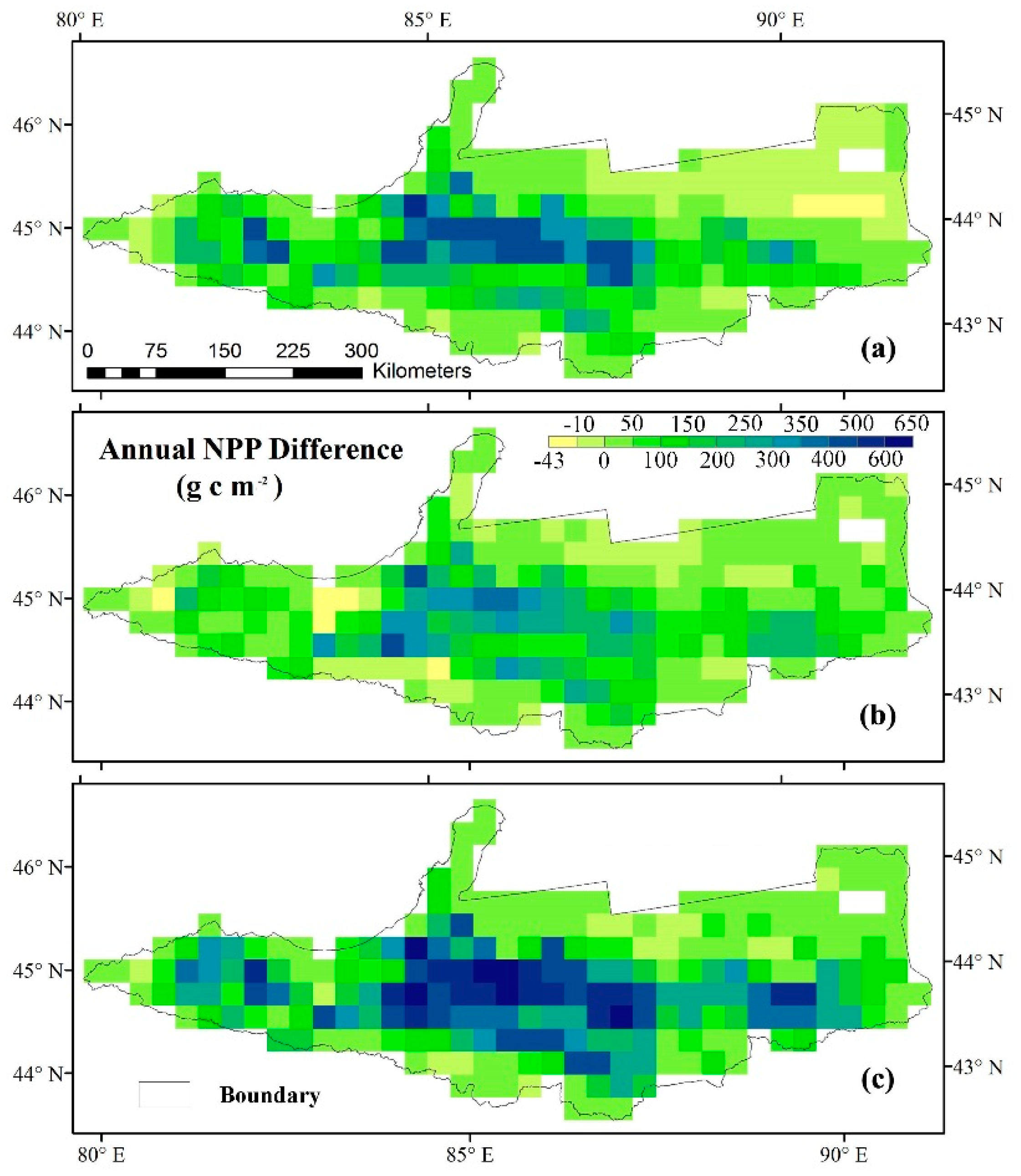
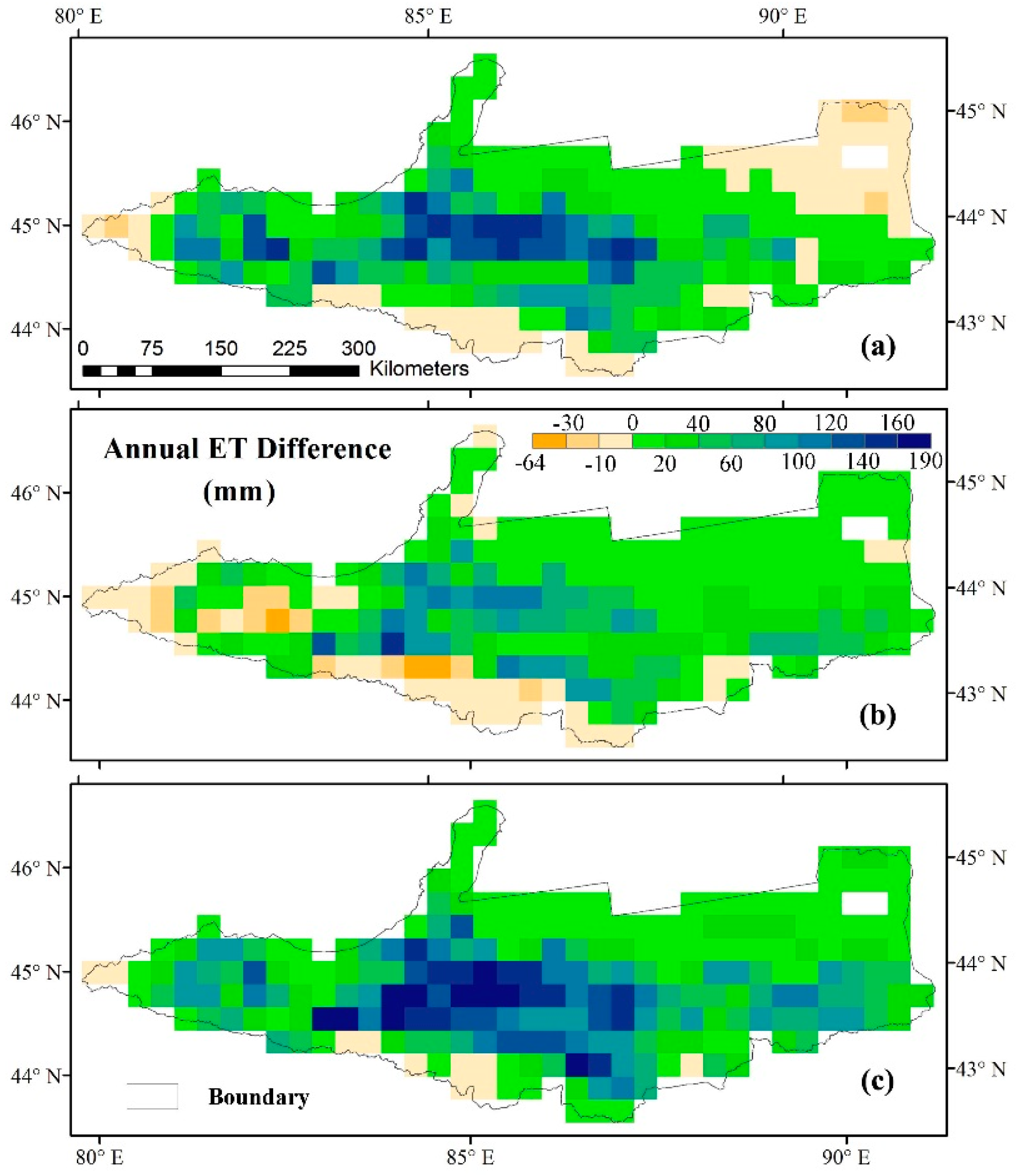



| Inputs | Unit | Methods and Sources |
|---|---|---|
| Base maps | ||
| Elevation | m | Aggregated from 30 m Advanced Spaceborne Thermal Emission and Reflection Radiometer (ASTER) Global Digital Elevation Model Version 2 data set (http://gdem.ersdac.jspacesystems.or.jp/) |
| Aspect | Degree | |
| Slope | Degree | |
| Soil texture | % | Extracted from the data set of soil properties for land surface modeling (http://westdc.westgis.ac.cn) |
| Soil pH | − | |
| Soil bulk density | g cm−3 | |
| Vegetation | Xinjiang and Central Asia scientific data sharing platform (http://midasia.geodata.cn/Portal/index.jsp) | |
| Transient data | ||
| Groundwater level | m | Cold and Arid Regions Science Data Center at Lanzhou (http://westdc.westgis.ac.cn) |
| CO2 | ppmv | Predefined CO2 concentration under RCP2.6, RCP4.5, and RCP8.5 [39] |
| Precipitation | mm | Dynamic downscaled daily climate data set |
| Solar radiation | W m−2 | |
| Relative humidity | % | |
| Maximum, minimum and average temperature | °C |
| Rate | Precipitation (mm/Decade) | Temperature (°C/Decade) | ||||
|---|---|---|---|---|---|---|
| Period | 2006–2035 | 2036–2055 | 2006–2055 | 2006–2035 | 2036–2055 | 2006–2055 |
| RCP2.6 | 16.2 | 6.4 | 6.5 | 0.30 | 0.12 | 0.22 |
| RCP4.5 | 14.1 | −4.5 | 9.0 | 0.40 | 0.35 | 0.24 |
| RCP8.5 | 12.2 | 4.2 | 11.8 | 0.42 | 0.30 | 0.49 |
| Rate | NPP (g C m−2 year−1) | ET (mm year−1) | ||||
|---|---|---|---|---|---|---|
| Period | 2006–2035 | 2036–2055 | 2006–2055 | 2006–2035 | 2036–2055 | 2006–2055 |
| RCP2.6 | 2.16 | 0.43 | 1.16 | 0.82 | 0.14 | 0.38 |
| RCP4.5 | 2.67 | −0.75 | 1.62 | 0.87 | −0.50 | 0.43 |
| RCP8.5 | 2.44 | 1.42 | 2.15 | 0.77 | −0.13 | 0.52 |
| Scenario | RCP2.6 | RCP4.5 | RCP8.5 | |||||||
|---|---|---|---|---|---|---|---|---|---|---|
| Period | 2006–2035 | 2036–2055 | 2006–2055 | 2006–2035 | 2036–2055 | 2006–2055 | 2006–2035 | 2036–2055 | 2006–2055 | |
| NPP | TNF | 1.30 | 0.59 | 0.62 | 1.35 | −0.08 | 0.87 | 1.40 | 0.88 | 1.29 |
| TBF | 1.24 | 0.30 | 0.50 | 1.02 | −0.77 | 0.69 | 0.89 | 0.43 | 0.94 | |
| GRS | 1.91 | −0.21 | 0.92 | 1.70 | 0.18 | 1.37 | 1.85 | 1.07 | 1.84 | |
| NPS | 2.93 | −1.17 | 1.16 | 1.37 | −0.52 | 1.52 | 0.70 | 1.27 | 2.06 | |
| PS | 3.13 | −0.59 | 1.08 | 2.41 | −1.91 | 1.18 | 0.72 | 2.21 | 2.33 | |
| CRP | 1.11 | 0.31 | 0.59 | 1.70 | −0.65 | 0.77 | 1.28 | 0.40 | 0.80 | |
| STL | 2.47 | 0.02 | 0.82 | 1.32 | −0.42 | 1.27 | 1.63 | 0.88 | 1.56 | |
| SPT | 1.34 | 0.28 | 0.72 | 1.14 | 0.34 | 0.87 | 1.61 | 0.86 | 1.43 | |
| ET | TNF | 0.75 | 0.52 | 0.35 | 0.82 | −0.24 | 0.46 | 0.85 | 0.41 | 0.76 |
| TBF | 0.67 | 0.10 | 0.22 | 0.35 | −0.64 | 0.21 | 0.37 | −0.16 | 0.35 | |
| GRS | 0.83 | −0.04 | 0.33 | 0.59 | −0.12 | 0.42 | 0.63 | 0.07 | 0.60 | |
| NPS | 1.11 | 0.06 | 0.34 | 0.62 | −0.56 | 0.39 | 0.65 | 0.07 | 0.55 | |
| PS | 1.34 | 0.16 | 0.50 | 1.04 | −0.66 | 0.53 | 0.27 | 0.57 | 0.77 | |
| CRP | 0.51 | 0.14 | 0.28 | 0.82 | −0.59 | 0.29 | 0.53 | −0.31 | 0.16 | |
| STL | 0.99 | −0.10 | 0.26 | 0.33 | −0.37 | 0.35 | 0.60 | 0.08 | 0.49 | |
| SPT | 0.56 | 0.14 | 0.28 | 0.42 | −0.02 | 0.26 | 0.63 | 0.10 | 0.55 | |
© 2020 by the authors. Licensee MDPI, Basel, Switzerland. This article is an open access article distributed under the terms and conditions of the Creative Commons Attribution (CC BY) license (http://creativecommons.org/licenses/by/4.0/).
Share and Cite
Cai, P.; Li, C.; Luo, G.; Zhang, C.; Ochege, F.U.; Caluwaerts, S.; De Cruz, L.; De Troch, R.; Top, S.; Termonia, P.; et al. The Responses of the Ecosystems in the Tianshan North Slope under Multiple Representative Concentration Pathway Scenarios in the Middle of the 21st Century. Sustainability 2020, 12, 427. https://doi.org/10.3390/su12010427
Cai P, Li C, Luo G, Zhang C, Ochege FU, Caluwaerts S, De Cruz L, De Troch R, Top S, Termonia P, et al. The Responses of the Ecosystems in the Tianshan North Slope under Multiple Representative Concentration Pathway Scenarios in the Middle of the 21st Century. Sustainability. 2020; 12(1):427. https://doi.org/10.3390/su12010427
Chicago/Turabian StyleCai, Peng, Chaofan Li, Geping Luo, Chi Zhang, Friday Uchenna Ochege, Steven Caluwaerts, Lesley De Cruz, Rozemien De Troch, Sara Top, Piet Termonia, and et al. 2020. "The Responses of the Ecosystems in the Tianshan North Slope under Multiple Representative Concentration Pathway Scenarios in the Middle of the 21st Century" Sustainability 12, no. 1: 427. https://doi.org/10.3390/su12010427
APA StyleCai, P., Li, C., Luo, G., Zhang, C., Ochege, F. U., Caluwaerts, S., De Cruz, L., De Troch, R., Top, S., Termonia, P., & De Maeyer, P. (2020). The Responses of the Ecosystems in the Tianshan North Slope under Multiple Representative Concentration Pathway Scenarios in the Middle of the 21st Century. Sustainability, 12(1), 427. https://doi.org/10.3390/su12010427






